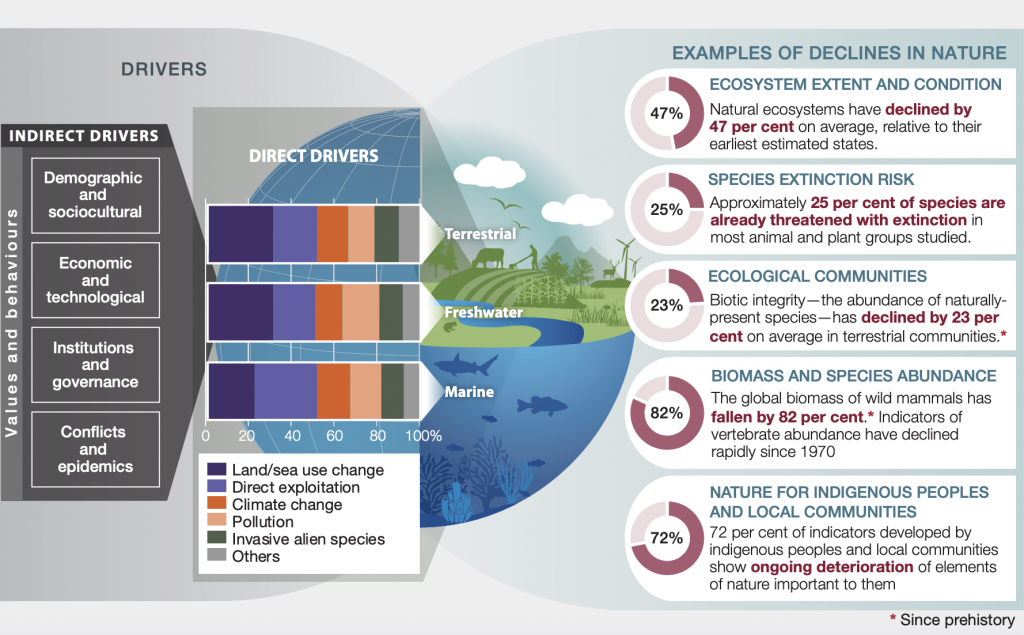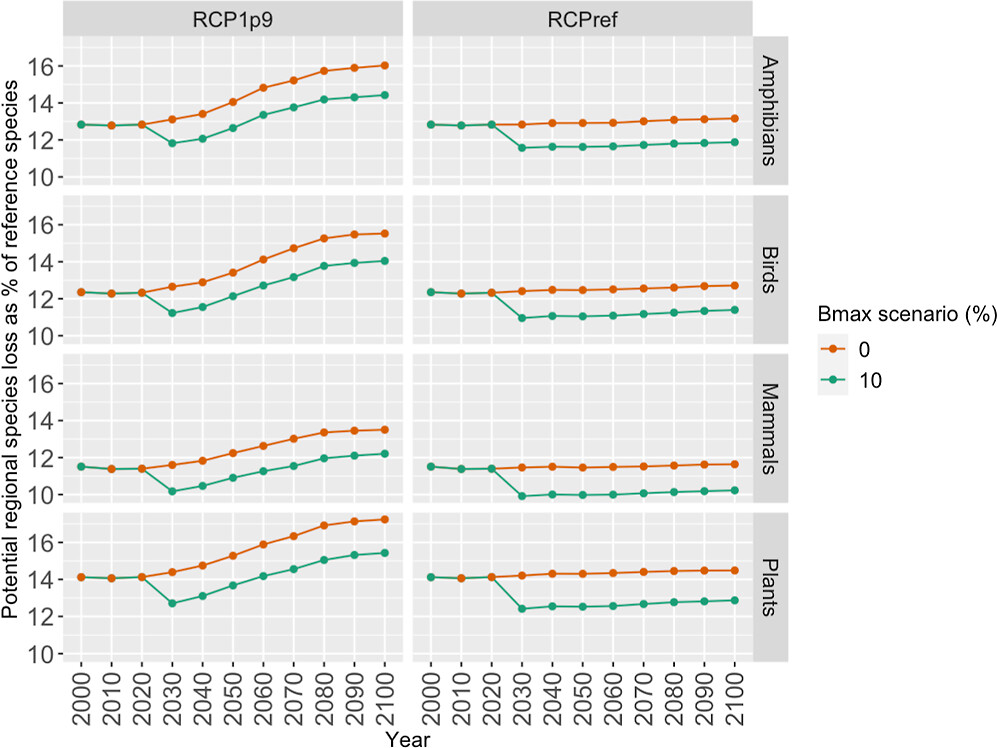The development and proliferation of human societies has gone hand in hand with extensive rates of biodiversity loss, to the point that many believe we are now in the midst of a sixth mass extinction. To make matters worse, every extra degree Celsius in temperature rise due to climate change is further exacerbating the risk of species extinction and ecosystem degradation.
Although the full extent of the consequences of these epochal changes is still unknown, what is certain is that biodiversity loss will have profound impacts not only on ecosystems but also on humans.
“The interlinkages between biodiversity loss and climate change are double sided and particularly relevant in terms of their impacts on multiple planetary boundaries,” says Simone Mereu, researcher at the National Research Council of Italy and CMCC. “Climate change is having an effect on the distribution of species and ecosystems. At the same time biodiversity loss reduces, and even reverses, the capacity of ecosystems to store carbon, which leads to a further loss in climate change mitigation potential.”
The role of science in providing the tools for understanding, monitoring and tackling these changes in ways that aid decision makers is key. In its most recent global assessment report, the Intergovernmental Science-Policy Platform on Biodiversity and Ecosystem Services (IPBES) – the world’s leading scientific authority on nature – confirmed that the conservation and sustainable use of nature can only be achieved through transformative societal change, which requires innovative research and scientific enquiry.
Science is already taking a central role in multilateral processes and efforts to safeguard biodiversity. At the Sixteenth meeting of the Conference of the Parties to the Convention on Biological Diversity (COP 16), which is currently underway in Colombia, policymakers are reviewing the state of implementation of the Kunming-Montreal Global Biodiversity Framework, which was adopted at the fifteenth meeting of the Conference of the Parties (COP 15). This historic agreement, committing nations to halt and reverse nature loss by 2030, relies on science and collaboration for its success.
“At COP16 the world will take stock of the targets and commitments that have been set, in an effort to see if in fact we are on course to becoming nature-positive,” says Mereu who believes that science and research have manyfold roles in addressing the twin biodiversity and climate change crises, including contributing to global biodiversity monitoring networks, the development of digital twins, further development of Earth System Models, and increasing our understanding of how ecosystem functions and services respond to various pressures.

The global land squeeze
According to the United Nations Environment Program, the main driver of biodiversity loss remains use of land by humans, primarily for food production. Although humans will continue to require additional land for food, fuel, and shelter they must also find ways to protect ecosystems as these are just as important to their wellbeing.
Biodiversity conservation strategies must therefore be formulated in the context of climate change and societal development, just as strategies to mitigate climate change must consider the impact on socio-ecological systems and their ability to adapt. This implies operating in a global arena dictated by three main challenges: mitigating climate change, halting biodiversity loss, and managing conflicting land use interests.
“The global land squeeze is an important concept and one of the biggest challenges we face in protecting biodiversity,” echoes Mereu. “A non-negotiable ingredient to addressing this issue is a participative governance approach at multiple levels, from the global to the municipal, and a recognition of the fact that excessive expansion of agricultural land and current approaches to land management are not compatible with a healthy biosphere and society.”
Part of the issue is ensuring that biodiversity concerns are included in the tools that are used to plan land management strategies, such as land use optimization models. In a recent paper, CMCC researcher Cindy Azuero looks at how biodiversity protection and climate change mitigation can be included in models, using an approach that integrates ecological contributions into economic decisions.
This is critical as land use change decisions affect communities and their economies through agriculture and forests, but also affect ecosystems and biodiversity through land use transformations and resulting habitat loss.
“There is a need for more research into models that include interconnectedness between functional biodiversity and biophysical processes driving the climate and hydrological cycle to aid decision makers,” explains Mereu.

An approach that is not only relevant to agricultural processes but can also be applied to other land intensive sectors such as forestry for example. In another research paper from 2024, CMCC researchers incorporate biodiversity into forest management decisions, showing how biodiversity-conscious decision making can alleviate the trade-off between conservation and climate change mitigation with high biomass requirements.
“Given the complex nature of ecosystems and the mosaic of landscapes where people live alongside heavily modified environments, we need a new paradigm where people can live sustainably, ensuring biodiversity and wellbeing,” explains Donatella Spano, Professor at University of Sassari, vice-president of CMCC and Spoke Leader for the National Biodiversity Future Centre (NBFC), Italy’s first National Research and Innovation Center dedicated to biodiversity.
“In the context of biosphere integrity, we also need to address genetic diversity, with species extinction rates serving as a key indicator, and consider functional diversity, which can be a good proxy of ecosystem functions and their resilience to disturbances” says Spano, who strongly believes in the importance of investing in biodiversity research for climate resilience.
Data and policy
Another vital contribution that research into biodiversity can give involves tapping into the value of natural capital, which at its core implies challenging our understanding of the relationship between economy, society, and the environment.
“Ecosystems depend on biodiversity to remain resilient and provide essential services such as clean air, water regulation, pollination, and microclimate buffering,” says CMCC researcher Antonio Trabucco, who believes that investment in biodiversity research will benefit numerous industries whilst at the same time conserving nature.
Research and programs that advance our understanding of the links between species and community traits, ecological functions and ecosystem services – both on land and at sea – and how they are impacted by climate change will involve generating precise data, as well as effective ecosystem management and monitoring.
“The availability of data and creation of reliable modeling functions, such as those used in Earth System Models, must also be accompanied by a multi-actor and multi-level governance approach,” says Trabucco, who is also the Scientific Leader behind CMCC’s partnership in the NBFC.
“The goal of the NBFC is to identify suitable strategies for monitoring, conserving, restoring and valorising the biodiversity of species and habitats in different Italian regions, in an effort to meet the goal of protecting 30% of the Italian territory by 2030 and generate socio-economic value,” says Trabucco, who sees this as a vital step towards meeting the goals set out by the EU and enshrined in the Global Biodiversity Framework.
The success of this approach revolves around linking local intervention structures and citizens through dedicated projects and specific knowledge tools, enhancing research efforts and simultaneously making knowledge, data and technologies accessible to diverse actors working on the local scale.
“CMCC’s contribution to the NBFC digital platform involves the implementation of models to assess future distributions of species and interlinkages between climate and biosphere integrity,” says Trabucco. “The work carried out by CMCC will contribute to the creation of tools that assess ecosystem services and mitigate biodiversity loss by identifying vulnerable areas and experimenting with scenarios of alternative mixed species management and land use changes.”
Land and oceans: Nature-based solutions are key
Linking efforts to mitigate climate change and protect biodiversity often revolve around implementing nature-based solutions, as these can provide multiple environmental, social and economic benefits at the same time.
However, finding the right kind of nature-based solutions and understanding how to implement them is not always straightforward, whether it be land or marine based ones. Once again, research will play a key role in this process as scientific enquiry can be used to assess the role of any given nature-based solution in both climate regulation and providing vital ecosystem services.
To this end, the EU-funded FutureMARES project provides nature-based solutions for climate change adaptation and mitigation in marine ecosystems. As part of this project, CMCC has developed high-resolution climate projections for European waters, including the North Sea, Baltic Sea, Bay of Biscay, and Mediterranean Sea, whilst focusing on five key ocean health indicators: temperature, salinity, pH, oxygen, and chlorophyll.
These kinds of projections identify climate change hotspots and provide valuable information for implementing effective adaptation measures, including nature-based solutions.
“The level of annual investments in nature-negative activities continues to be far too high, whereas investments in nature-based solutions is insufficient,” says Spano in her closing statements. “However, the results we have achieved, tools developed, and information generated put our communities and CMCC in a strong position to advocate for more effective solutions.”
Society is at a shed-water moment in which strategies that take a holistic approach to the twin crisis of climate change and biodiversity loss can play a key role in accelerating transformative change. This will require cutting edge research that can identify appropriate indicators, evaluation tools and integrated assessment methods to identify criticalities and solutions that bring together strategies for biodiversity and ecosystem restoration with those aimed at tackling climate change.
In contrast, failing to act on biodiversity will increase human vulnerability, accelerate climate change and lead to higher risks of poverty, food insecurity, involuntary displacement, political instability and conflict.






